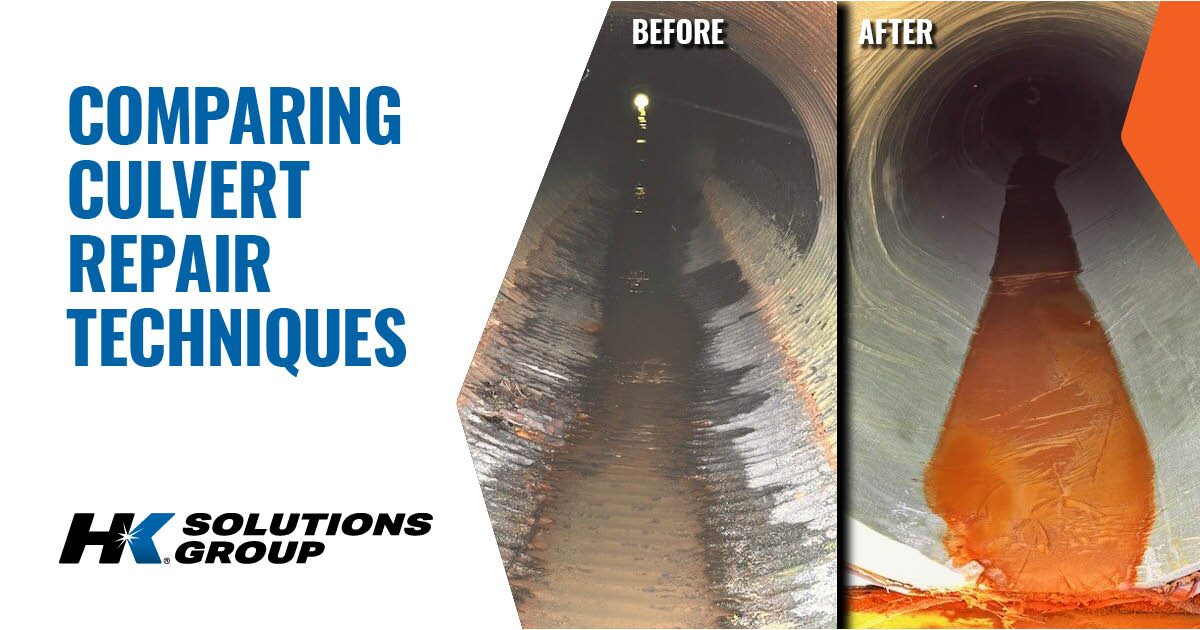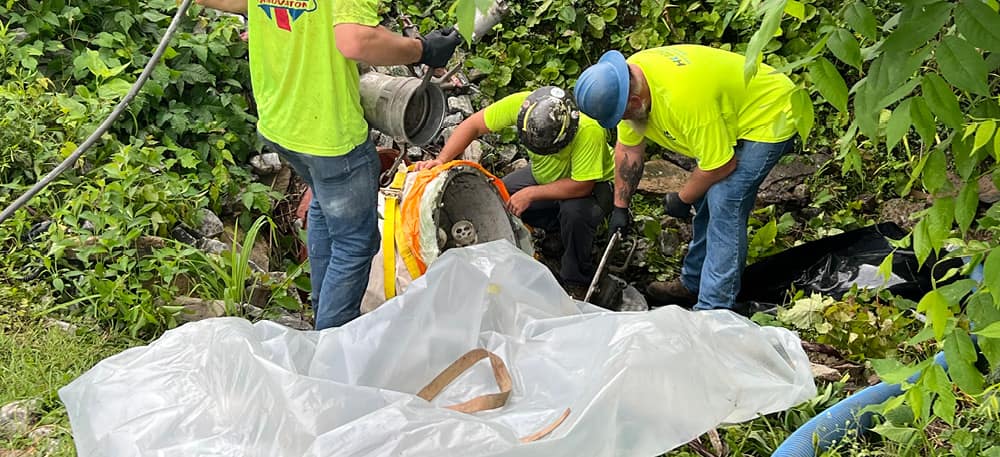Breaking Down the Best Storm Sewer & Culvert Repair Techniques
June 17, 2024

The Department of Homeland Security identifies flooding as the most destructive natural disaster to occur in the United States, inflicting more damage and taking more lives than any other natural catastrophe each year. In fact, 90 percent of all natural disasters in the U.S. involve flooding. Yet, life-saving infrastructure like culverts, storm drains and other large diameter pipes are often the most neglected portion of a municipal sewer system. Because they play such a pivotal role in diverting stormwater and runoff from roadways, taking them out of commission for necessary repairs poses challenges. But not all culvert repair techniques are created equal.
Through trenchless storm sewer repair and municipal culvert lining solutions, you can prevent culvert failure and restore deteriorating structures in your community safely and efficiently. Better yet: you don’t need to disrupt traffic, utilities or the surrounding environment to do it.
Why do culverts fail?
Culvert failure stems from a number of underlying causes, but the main culprits are heavy traffic, old age and exposure to elements like major storms or erosion. And without regular maintenance, municipalities risk exacerbating deterioration as issues like corrosion and wear and tear persist.
For example, if debris accumulates unchecked without culvert cleanings scheduled, the resulting blockage can slow down water flow, placing additional pressure on the pipe. Subsequent cracks and leaks can occur, leading to additional issues, like eroding soil surrounding the structure. As the damage compounds, the declining stability of the culvert becomes a major threat to community safety and nearby utilities. A total failure spells disaster for the infrastructure the large diameter pipe supports, leaving roads susceptible to flooding and hazardous travel conditions.
Often, routine pipe inspections and cleanings help prevent culvert damage from escalating to this point, but sometimes, more advanced culvert repair is required to seal and strengthen the structure. Large diameter pipes and storm sewer structures naturally deteriorate over time, so if it’s been a while since you checked in on the culverts in your community, consider a professional inspection to determine their condition. If you’re unsure about what requires professional attention, be on high alert for the warning signs of culvert failure.
How to Spot Potential Culvert Failure
Visible signs of culvert failure include cracks in the structure, debris in the pipe opening and mis-aligned joints, indicating shifts in the surrounding soil, while standing water near the culvert points to serious flow issues. Similarly, dangerous sinkholes and unstable terrain are tell-tale red flags highlighting the necessity of structural storm sewer repair.
Still, without a formal sewer inspection, deeper issues and defects are easy to miss. Sewer camera technology pinpoints problematic areas and helps sewer professionals identify the most cost-effective culvert repair techniques.

Structural Culvert Repair Solutions
Today’s trenchless technology opens the door for no-dig culvert repair techniques to provide long-lasting structural stability for stormwater systems. Although there are several trenchless options for culvert repair, preferred storm sewer repair solutions like UV-cured pipe lining strengthen structures while avoiding the destruction and expenses of a traditional pipe replacement.
Traditional Culvert Replacement
Traditionally, the solution for culvert failure was digging up the defective pipe and replacing it with a new one. To get the job done, municipal planners would have to reroute traffic, dig up a paved road or busy railway, coordinate heavy equipment and restore the destroyed area afterward. Inconvenient and costly, the damage required to install a new large diameter pipe often diminished the benefit of using a brand new structure.
Digging up your community’s critical infrastructure is an outdated approach that drains municipal funds and greatly prohibits necessary functions like the steady flow of traffic and uninterrupted utility access. Thankfully, trenchless culvert repair techniques are designed with a full lifespan in mind. The result is still a fully restored and structurally sound large diameter pipe ready to weather the storms ahead.
Culvert Slip Lining
The culvert slip lining process seals and strengthens the existing culvert by introducing a smaller pipe (known as the carrier pipe), typically made of durable thermoplastics like high-density polyethylene or PVC, into the structure’s host pipe. Once technicians insert the carrier pipe into the culvert foundation, they grout the two pipes together, ensuring both ends are sealed and essentially creating a new, reinforced pipe. Unfortunately, traditional CIPP methods such as this are not appropriate for all applications as they’re known to leak styrene into the surrounding environment.
Thermoform Culvert Lining
PVC thermoplastic was previously a sought-after municipal culvert lining material because it’s safe for the environment, free of toxins and contaminants and has a flexible grip that binds well with failing pipe walls. Because the material responds well to and can be reformed through repeated heating and cooling, pipe professionals can work diligently to ensure every nook and cranny of the large diameter pipe is secure. However, this method lacks the efficiency of modern techniques like UV-cured pipe lining.
UV-Cured Pipe Lining
As HK’s preferred culvert lining technique, UV-cured pipe lining lends itself well to large diameter applications, including storm sewer and culvert repair services. After trained technicians measure and custom-design a UV-cured liner compatible with the existing pipe, they insert it into the structure, where it molds tightly to the culvert walls. This method of culvert lining is unique for its use of fiberglass and UV lighting as the curing agent, rather than felt and steam used in other lining techniques.
As one of the most efficient large diameter pipe rehabilitation techniques, the liner cures in just 10 minutes, effectively sealing cracks and restoring the deteriorating structure as it cements in place. UV-cured liners represent the best of trenchless technology because they enable quick, minimally invasive repairs without interrupting the daily traffic flow and utility usage of your community.
Why Municipalities Trust Trenchless Culvert Repair Techniques
Culvert repair techniques requiring digging are counterintuitive to the issues most municipalities are trying to solve: lessening damage to critical infrastructure, avoiding utility interruptions and getting it done while remaining a steward of the city’s budget. Creating more damage by digging doesn’t have to be the answer. Trenchless storm sewer repair methods save time and money. The best culvert lining solutions are essentially equivalent to a brand new pipe. That means you can prevent culvert failure and set your sewer structures up for long-term success by fortifying the foundations your community stands on to last decades into the future.

No community is immune to the damaging effects of floodwater, which means no community can afford to ignore its stormwater infrastructure. With reliable trenchless technology from leading storm sewer experts like HK Solutions Group, you never have to be in the position to choose between maintaining traffic and community necessities or ensuring safety and compliance. HK serves municipalities across the country with our one-of-a-kind no-dig solutions to ensure both can be prioritized simultaneously.
Contact HK Solutions Group to Avoid Culvert Failure with Reliable Storm Sewer Repair Services
HK’s specialization in large diameter trenchless pipe and storm sewer repair allows us to rehabilitate failing sewer structures of all shapes and sizes, as small as three inches in diameter all the way up to 86 inches. Our ability to service large diameter pipes is a unique offering not all contractors are equipped to take on. With our advanced pipe inspection technology and vast experience providing a variety of large diameter pipe and culvert repair techniques, we put our best foot forward at every job site, ensuring we’re using the best method for your needs. Call our team at (515) 283-0500 to learn more, or contact us online to get started.
Get Started With HK
James Macko
Connect With James On Large Diameter Pipe & Culvert Repair Needs
To contact James, reach out to him on LinkedIn or contact the HK team to get in touch.